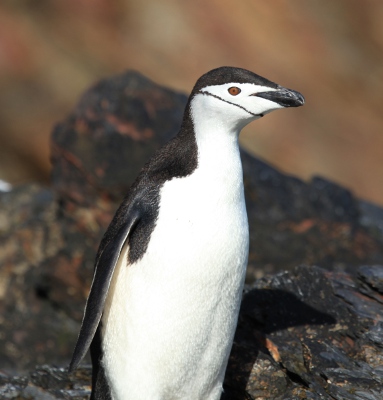Chinstrap Penguin
Category: Penguin

Facts about Chinstrap Penguins. "Scientific name for Chinstrap Penguins is Pygoscelis antarcticus". The Chinstrap Penguins live in rocky land, especially the Antarctic Ocean. The Chinstrap Penguin are a small penguin. Other names for the Chinstrap Penguin is Stonecracker Penguin, Ringed Penguin and Bearded Penguin. The Chinstrap Penguin is one of the three species of penguins classified as brush tail. The other two in this category are the Adelie and Gentoo Penguin.
Feature of the Chinstrap Penguin
The name Chinstrap Penguin comes from these penguins having a narrow band which is black and under their peak looks like a chinstrap. Chinstrap Penguin are very strong with very strong feet. They also have a short bill that is black colored. They survive in colder water than most species of penguins. This is due to their feathers that are packed tight together. This lets them be more insulated and water proof. The Chinstrap Penguin are a medium size as penguins go. The Chinstrap Penguin average in height from 18 to 24 inches (45.7 to 60.9) tall and they generally weigh from 5 to 9 pounds (2.2 to 4.4kg). The male Chinstrap Penguin are taller and heavier than the females.
Surprisingly, among all other species of Penguins, Chinstrap Penguins cannot go unnoticed because of that unique band around the mouth. Living on the islands, it is believed that the Chinstrap Penguin are more than seven million and they stay in groups.
Diet of the Chinstrap Penguin
The Chinstrap Penguin mainly feed on fish and other small creatures especially the krill. In fact the Chinstrap Penguin are carnivorous. In most of the times you will find chinstrap penguins in the surrounding waters hunting. When they need to rest, breed and escape from their predators, that’s when you will find them on the land. Chinstrap Penguin don't drink water, since they take in seawater as they swallow their meal and like all penguins, they have a that special gland that removes salt from their bodies after swallowing saltwater.
Chinstrap Penguin Predators
The Chinstrap Penguin are prone to danger because they have predators especially in the Ocean. But the good thing is that their predators are not many. You will discover that not many animals love living around the ocean. This is why the Chinstrap Penguins don’t have many predators since most of the time they spend around the ocean. Leopard Seal, Sea Birds and big animals like Killer Whale are their worst enemies.
Origin of the Chinstrap Penguin
The chinstrap penguins origin is the Antarctic Peninsula on South Shetland, South Georgia, South Orkney and South Sandwich Islands and the biggest majority live in the South Atlantic Ocean. When chinstrap penguins are breeding colonies they are found mainly on the Antarctic Peninsula and on sub-Antarctic islands of the South Atlantic.
Reproduction of the Chinstrap Penguin
Both female and male chinstrap penguins have a responsibility when it comes to bringing small penguins on earth. The female Chinstrap Penguin lays at least two eggs per year in a nest and this is either in November or December. The interesting thing is that they take turns in order to make sure that the eggs are warm thus enabling them to hatch.
After they hatch, the Chinstrap Penguin again make it their duty to feed the young penguins for another one month. They take the turns of going for hunting so that they can protect their young ones. You will never meet small chinstrap penguins abandoned. Their parents take care of them and then leave them after they can stand on their own.
Molting of the Chinstrap Penguin
Chinstrap Penguins have to eat a very large quantity of food when possible. They need to build up layers of fat. When they are on land for mating or when they are Molting -(of an animal-shed old hair skin, or an old shell, to make way for a new growth that will occur, the adult Penguin birds were already molting into their winter shades of gray), they rely on the layers of fat to help them survive, as when the time they are unable to go to the water for food. Chinstrap Penguin regularly preen (meaning of a bird, cleans and straighten its feathers with its beak)
"Scientific name for Penguin Sphenisciformes". The Chinstrap Penguin live about 15 to 20 years.

 Back To Category Penguin
Back To Category Penguin